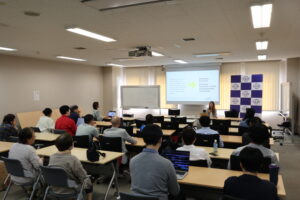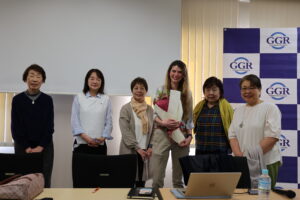On March 26, 2025, Hitotsubashi University’s Institute for Global Governance Research (GGR) hosted its 37th Brown Bag Lunch Seminar titled “Technology Transfer and Great Power Competition: The Case of Latin American Countries,” featuring Sascha Hannig Nunez, an international analyst and doctoral student at Hitotsubashi University.
Ms. Hannig emphasized the crucial role of technology transfer in shaping societies and economic development, as well as its role in international relations. She particularly explored the context of the US-China rivalry. For Latin America, tech transfers present both opportunities and risks—fostering development while also raising concerns about dependency and digital sovereignty. As global tech standards diverge, Latin American countries must weigh economic benefits against security and foreign influence. The region’s diversity—ranging from established democracies to hybrid and authoritarian regimes—adds complexity. Latin America’s growing digital markets and strategic resources have attracted major global players. While the US and Europe have historically dominated the tech landscape, China now offers competitive alternatives, especially in telecommunications, AI, and infrastructure. One contentious issue is the spread of facial recognition technologies. These tools raise alarms over privacy, human rights, and mass surveillance. Their use has sparked geopolitical tensions, with Western governments, particularly the US, highlighting data security risks. The rollout of 5G networks further illustrates the geopolitical stakes. China, through firms like Huawei and ZTE, leads infrastructure development with affordable solutions, while the US warns against potential dual use. Countries such as Brazil and Chile are considered at the forefront of adoption, but also face strategic decisions that will shape their digital futures, alliances, and sovereignty.
In the Q&A session, an important question related to the discrepancies between maintaining a close alliance with the United States and engaging with China for technology transfers was explored. In particular, regarding the case of Chile, where Beijing’s influence is rampant despite the country suspending technology-related contracts, Ms. Hannig emphasized the role of Chile as a regional institutional model. However, she also noted the increasing efforts from Chinese actors to influence key politicians in Chile, including the president of the Lower Chamber of Parliament and one of the main candidates for the Chancellor position.
In conclusion, technology transfer in Latin America is framed within global competition dynamics, but it takes a counter-intuitive shape in terms of policy output, as neither China or the US have achieved their diplomatic objectives despite their widespread presence in other areas. To safeguard digital sovereignty and promote sustainable development, governments must strengthen local technological capabilities and adopt a balanced, strategic approach when engaging with global powers.
[Report Prepared By] Billal Hossain (PhD Student, Graduate School of Law, Hitotsubashi University)



